Abstract
There is considerable evidence that the level of deoxycholic acid in the bile influences biliary cholesterol saturation. Deoxycholic acid is formed in the colon and absorbed slowly. Hence changes in colonic transit rate might influence biliary deoxycholic acid and the cholesterol saturation of bile. When 14 constipated subjects took standardised senna tablets for six weeks in a dose sufficient to lower mean whole gut transit time from 134 to 54 hours, deoxycholic acid as a proportion of biliary bile acids fell from 25.9 +/- 8.6 to 17.2 +/- 8.3% (p less than 0.0001) and deoxycholic acid pool measured by isotope dilution fell from 0.64 +/- 0.34 to 0.45 +/- 0.29 g (p less than 0.0001). In those subjects (n = 8) whose bile was initially supersaturated with cholesterol, the saturation index fell from 1.40 +/- 0.22 to 1.20 +/- 0.19 (p = 0.02). Conversely, when 12 normal volunteers took loperamide capsules sufficient to cause symptomatic constipation and to prolong mean transit-time from 48 to 103 hours, the deoxycholic acid pool increased from 0.40 +/- 0.24 to 0.57 +/- 0.17 g (p = 0.008). The percentage deoxycholic acid did not alter significantly, because the estimated total bile acid pool expanded (from 1.98 +/- 0.61 to 2.81 +/- 0.48 g; p less than 0.001), presumably because of loperamide slowing down small bowel transit. Despite this expansion of the bile acid pool, loperamide increased the cholesterol saturation index from 1.10 +/- 0.31 to 1.20 +/- 0.32 (p = 0.01). Changes in colonic transit rate alter the size of the deoxycholic acid pool and bile cholesterol saturation. These findings suggest that constipation or slow colonic transit might increase the chance of supersaturated bile and hence of gall stones.
Full text
PDF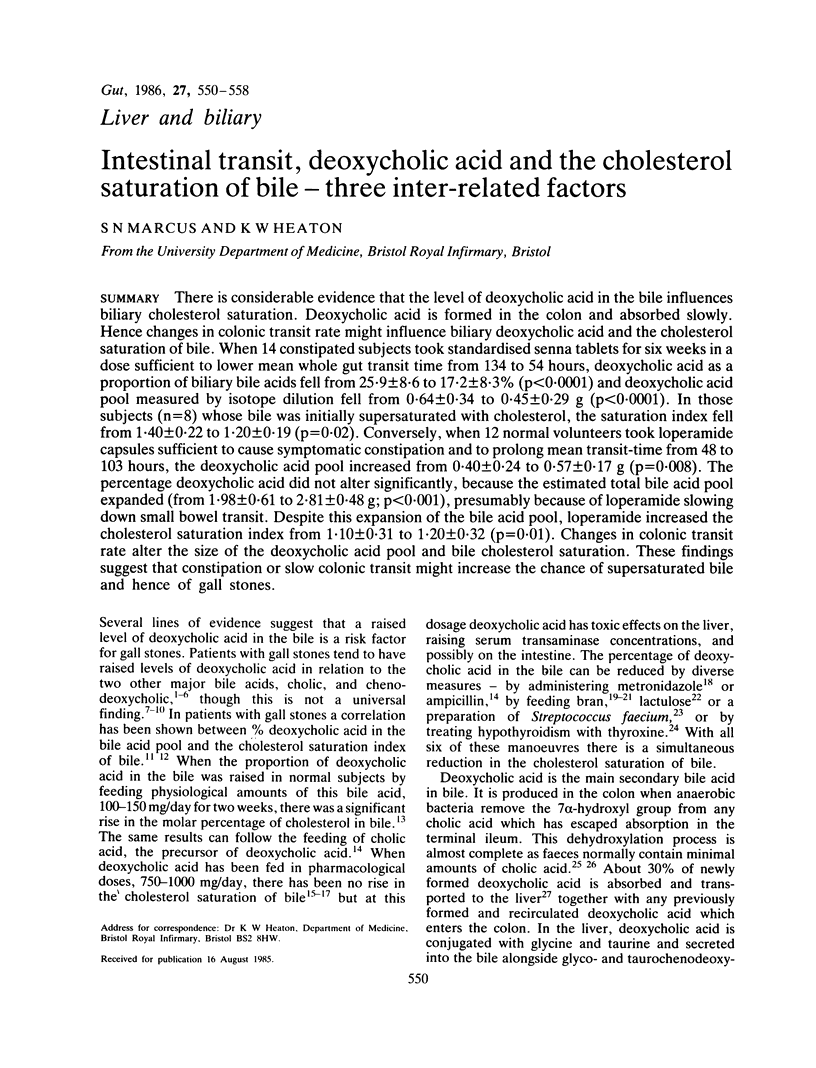
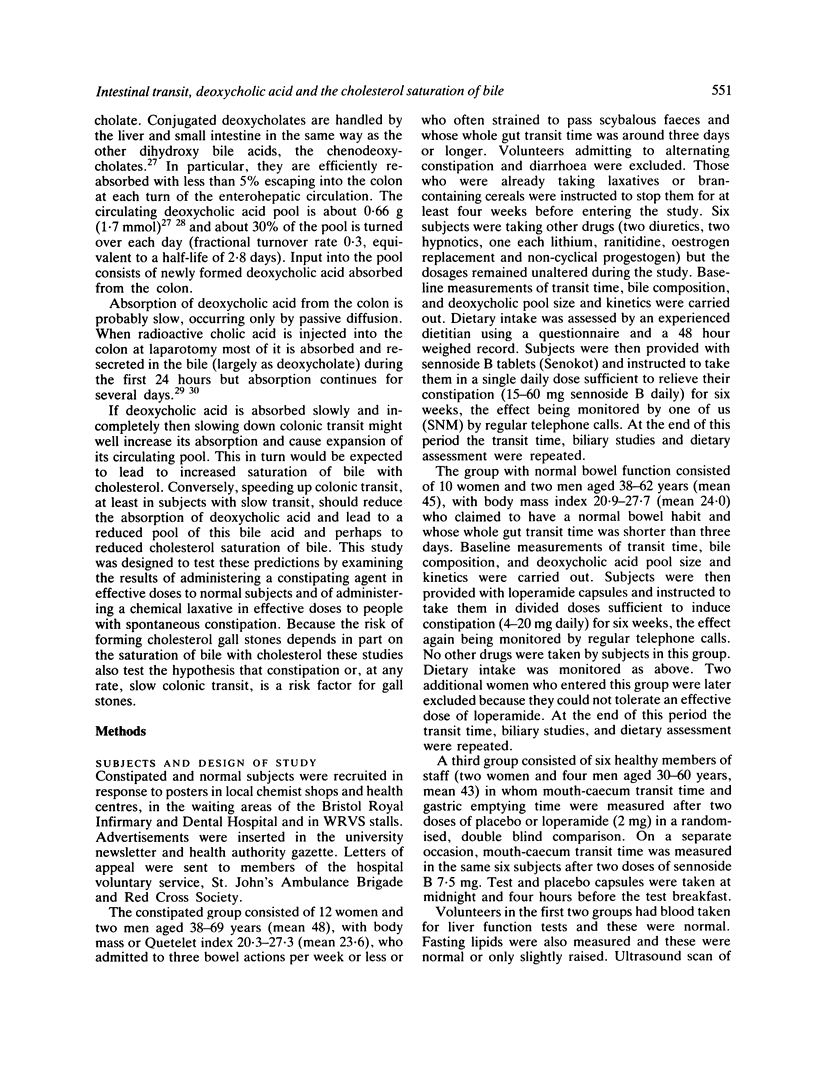
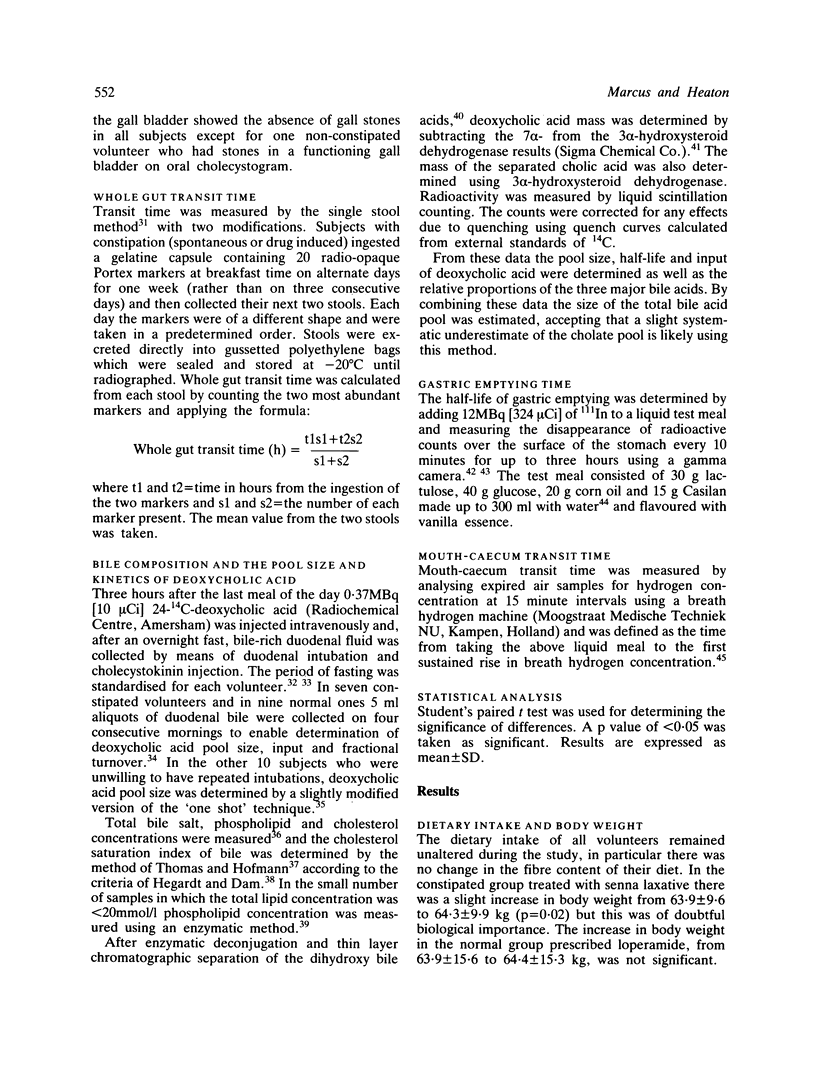
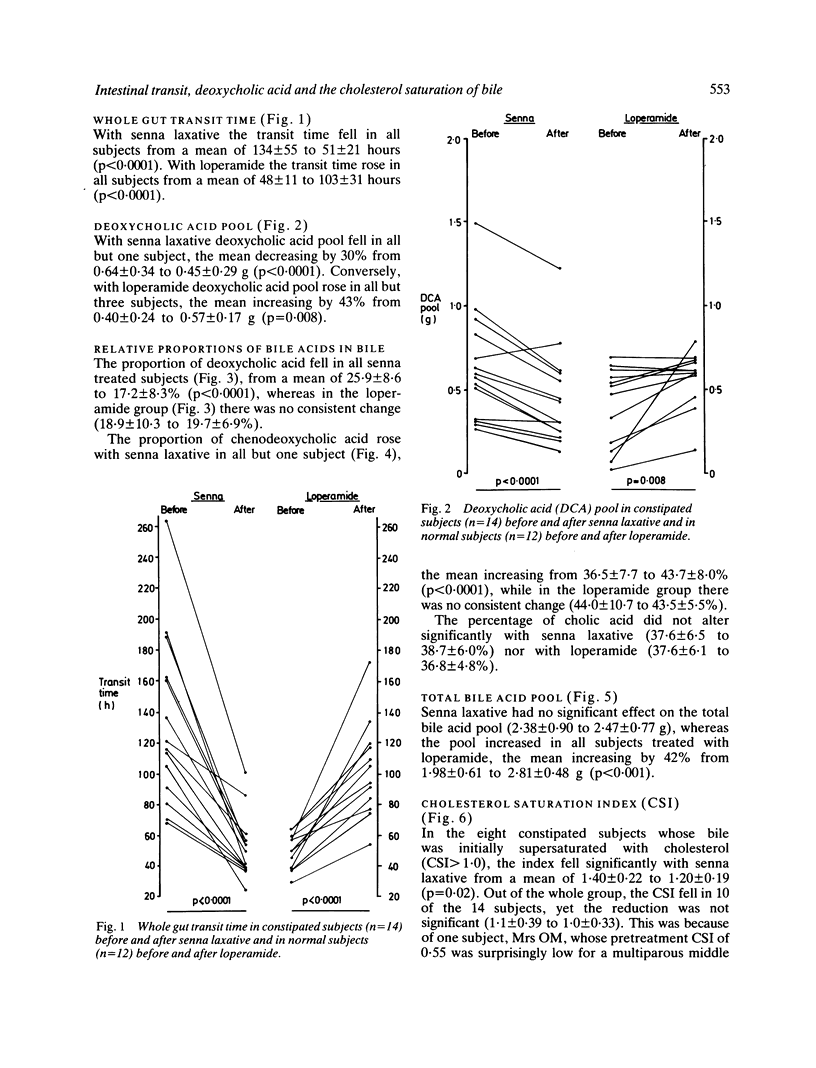
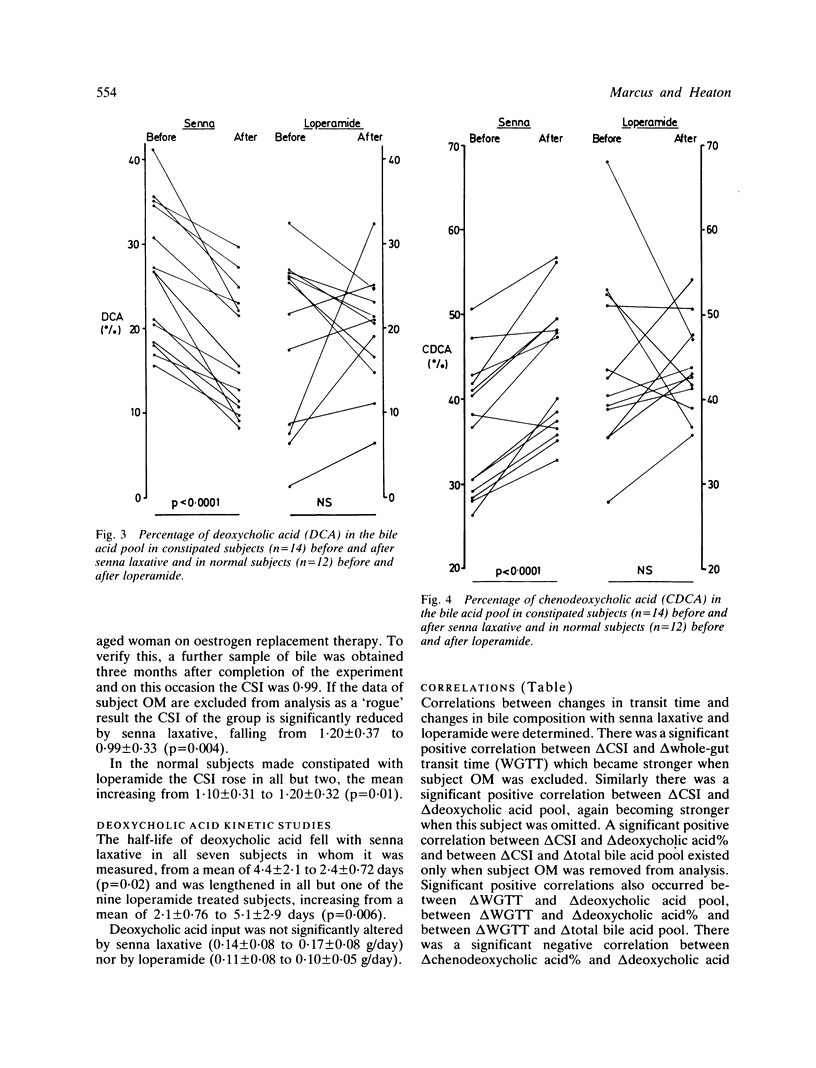
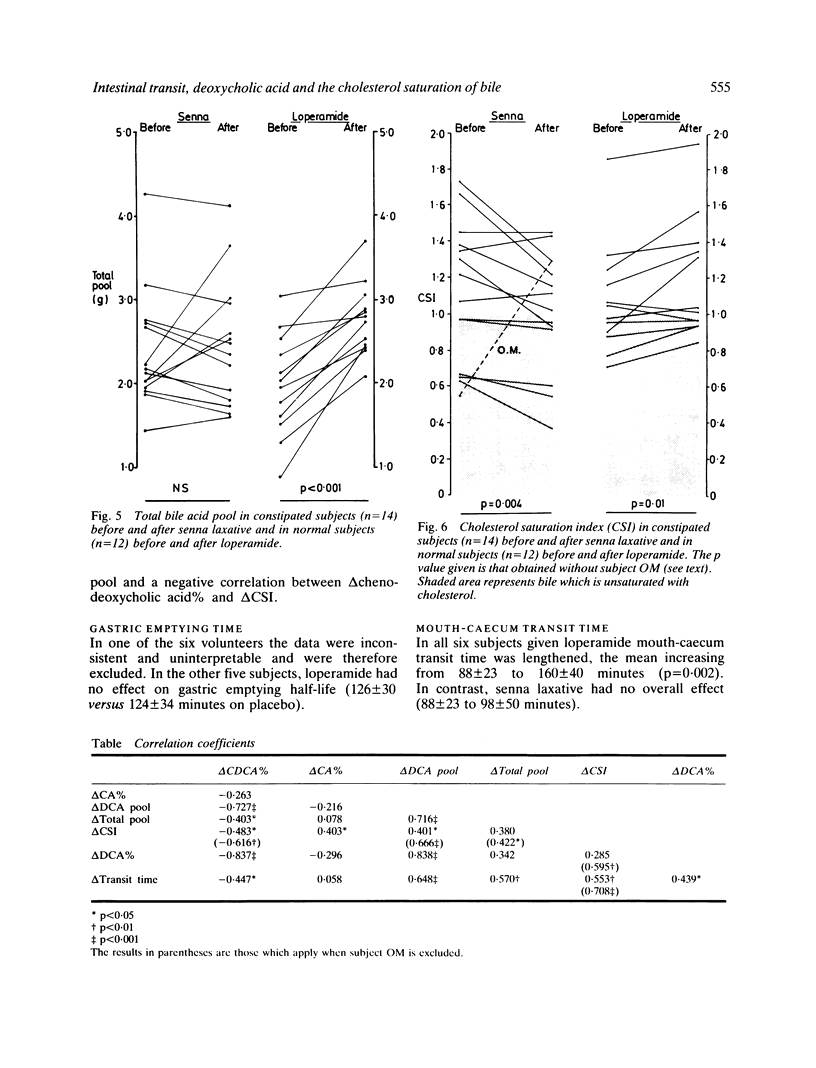
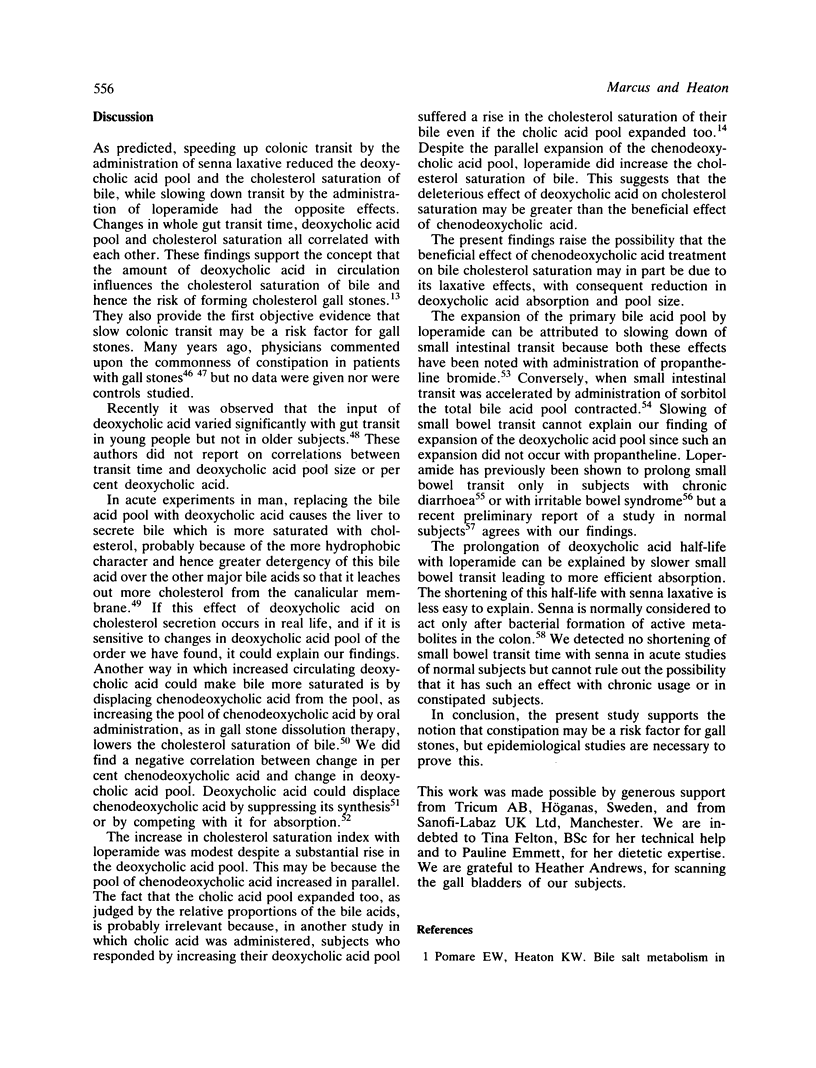
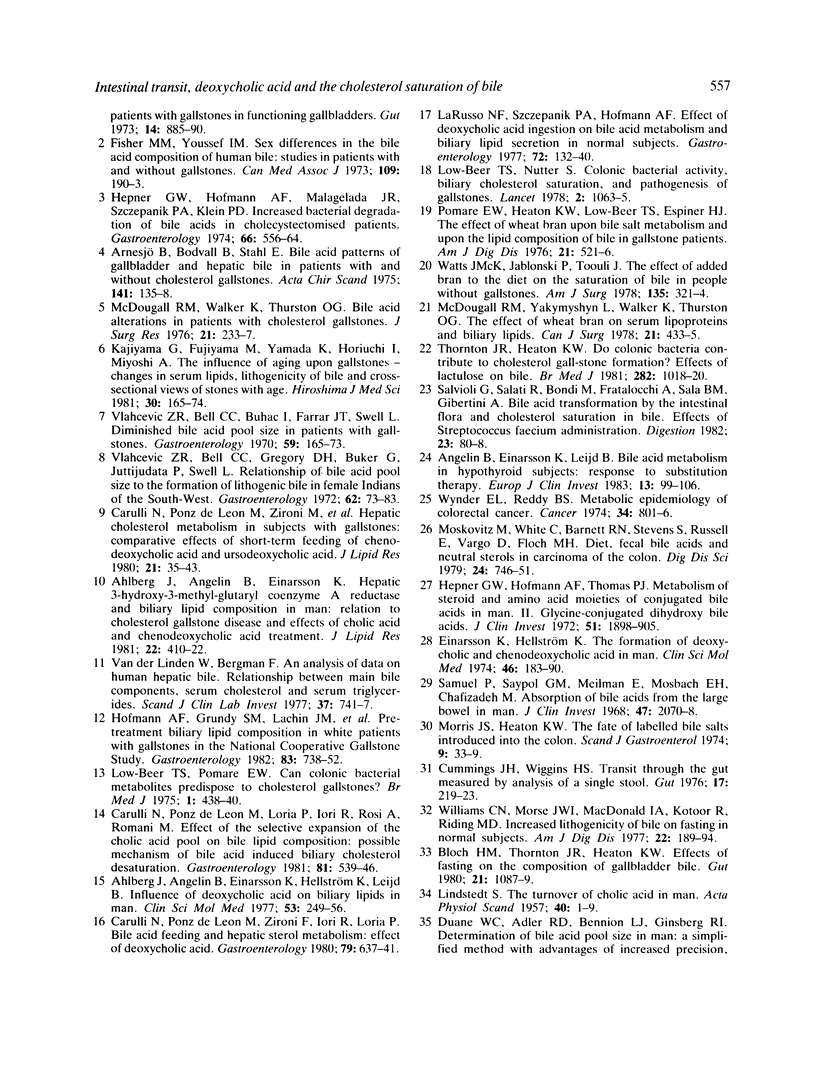
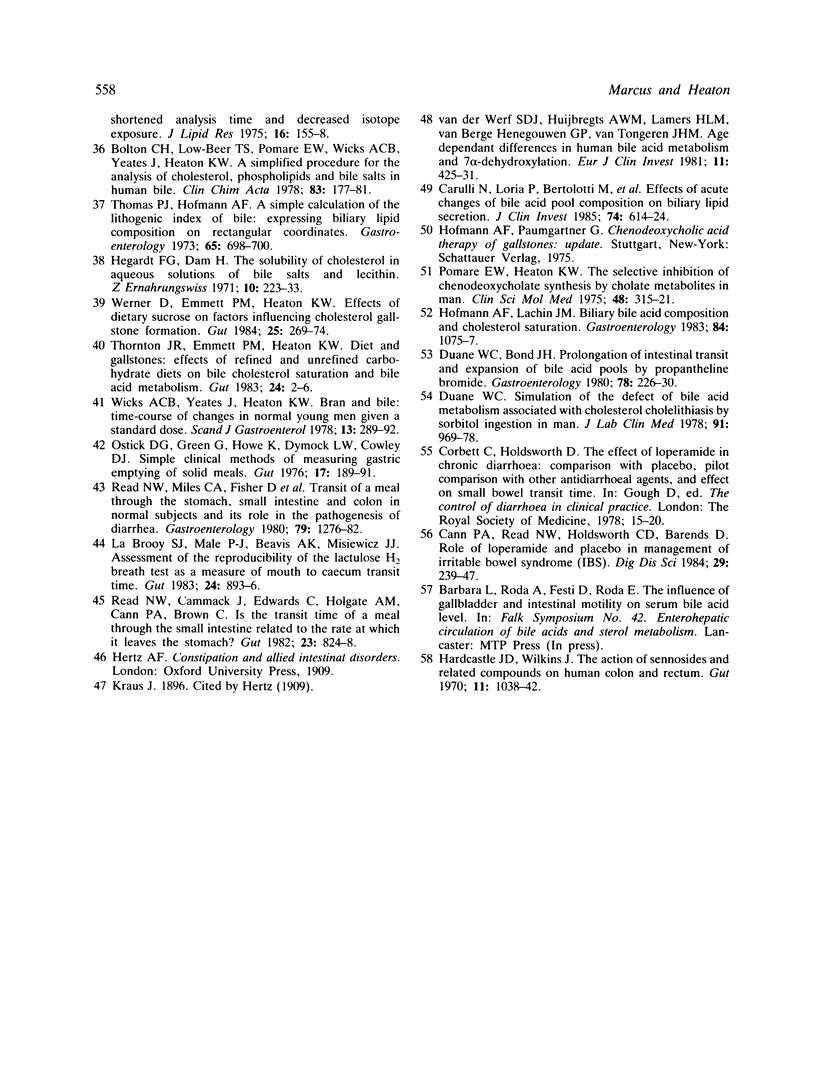
Selected References
These references are in PubMed. This may not be the complete list of references from this article.
- Ahlberg J., Angelin B., Einarsson K., Hellstrom K., Leijd B. Influence of deoxycholic acid on biliary lipids in man. Clin Sci Mol Med. 1977 Sep;53(3):249–256. doi: 10.1042/cs0530249. [DOI] [PubMed] [Google Scholar]
- Ahlberg J., Angelin B., Einarsson K. Hepatic 3-hydroxy-3-methylglutaryl coenzyme A reductase activity and biliary lipid composition in man: relation to cholesterol gallstone disease and effects of cholic acid and chenodeoxycholic acid treatment. J Lipid Res. 1981 Mar;22(3):410–422. [PubMed] [Google Scholar]
- Angelin B., Einarsson K., Leijd B. Bile acid metabolism in hypothyroid subjects: response to substitution therapy. Eur J Clin Invest. 1983 Feb;13(1):99–106. doi: 10.1111/j.1365-2362.1983.tb00071.x. [DOI] [PubMed] [Google Scholar]
- Arnesjö B., Bodvall B., Ståhl E. Bile acid pattern of gallbladder and hepatic bile in patients with and without cholesterol gallstones. Acta Chir Scand. 1975;141(2):135–138. [PubMed] [Google Scholar]
- Bloch H. M., Thornton J. R., Heaton K. W. Effects of fasting on the composition of gallbladder bile. Gut. 1980 Dec;21(12):1087–1089. doi: 10.1136/gut.21.12.1087. [DOI] [PMC free article] [PubMed] [Google Scholar]
- Bolton C. H., Low-Beer T. S., Pomare E. W., Wicks A. C., Yeates J., Heaton K. W. A simplified procedure for the analysis of cholesterol, phospholipids and bile salts in human bile. Clin Chim Acta. 1978 Feb 1;83(1-2):177–181. doi: 10.1016/0009-8981(78)90222-x. [DOI] [PubMed] [Google Scholar]
- Cann P. A., Read N. W., Holdsworth C. D., Barends D. Role of loperamide and placebo in management of irritable bowel syndrome (IBS). Dig Dis Sci. 1984 Mar;29(3):239–247. doi: 10.1007/BF01296258. [DOI] [PubMed] [Google Scholar]
- Carulli N., Loria P., Bertolotti M., Ponz de Leon M., Menozzi D., Medici G., Piccagli I. Effects of acute changes of bile acid pool composition on biliary lipid secretion. J Clin Invest. 1984 Aug;74(2):614–624. doi: 10.1172/JCI111459. [DOI] [PMC free article] [PubMed] [Google Scholar]
- Carulli N., Ponz De Leon M., Zironi F., Pinetti A., Smerieri A., Iori R., Loria P. Hepatic cholesterol and bile acid metabolism in subjects with gallstones: comparative effects of short erm feeding of chenodeoxycholic and ursodeoxycholic acid. J Lipid Res. 1980 Jan;21(1):35–43. [PubMed] [Google Scholar]
- Carulli N., Ponz de Leon M., Loria P., Iori R., Rosi A., Romani M. Effect of the selective expansion of cholic acid pool on bile lipid composition: possible mechanism of bile acid induced biliary cholesterol desaturation. Gastroenterology. 1981 Sep;81(3):539–546. [PubMed] [Google Scholar]
- Carulli N., Ponz de Leon M., Zironi F., Iori R., Loria P. Bile acid feeding and hepatic sterol metabolism: effect of deoxycholic acid. Gastroenterology. 1980 Oct;79(4):637–641. [PubMed] [Google Scholar]
- Cummings J. H., Wiggins H. S. Transit through the gut measured by analysis of a single stool. Gut. 1976 Mar;17(3):219–223. doi: 10.1136/gut.17.3.219. [DOI] [PMC free article] [PubMed] [Google Scholar]
- Duane W. C., Adler R. D., Bennion L. J., Ginsberg R. L. Determination of bile acid pool size in man: a simplified method with advantages of increases precision, shortened analysis time, and decreased isotope exposure. J Lipid Res. 1975 Mar;16(2):155–158. [PubMed] [Google Scholar]
- Duane W. C., Bond J. H., Jr Prolongation of intestinal transit and expansion of bile acid pools by propantheline bromide. Gastroenterology. 1980 Feb;78(2):226–230. [PubMed] [Google Scholar]
- Duane W. C. Simulation of the defect of bile acid metabolism associated with cholesterol cholelithiasis by sorbitol ingestion in man. J Lab Clin Med. 1978 Jun;91(6):969–978. [PubMed] [Google Scholar]
- Einarsson K., Hellström K. The formation of deoxycholic acid and chenodeoxycholic acid in man. Clin Sci Mol Med. 1974 Feb;46(2):183–190. doi: 10.1042/cs0460183. [DOI] [PubMed] [Google Scholar]
- Fisher M. M., Yousef I. M. Sex differences in the bile acid composition of human bile: studies in patients with and without gallstones. Can Med Assoc J. 1973 Aug 4;109(3):190–193. [PMC free article] [PubMed] [Google Scholar]
- Hardcastle J. D., Wilkins J. L. The action of sennosides and related compounds on human colon and rectum. Gut. 1970 Dec;11(12):1038–1042. doi: 10.1136/gut.11.12.1038. [DOI] [PMC free article] [PubMed] [Google Scholar]
- Hegardt F. G., Dam H. The solubility of cholesterol in aqueous solutions of bile salts and lecithin. Z Ernahrungswiss. 1971 Apr;10(3):223–233. doi: 10.1007/BF02020933. [DOI] [PubMed] [Google Scholar]
- Hepner G. W., Hofmann A. F., Malagelada J. R., Szczepanik P. A., Klein P. D. Increased bacterial degradation of bile acids in cholecystectomized patients. Gastroenterology. 1974 Apr;66(4):556–564. [PubMed] [Google Scholar]
- Hepner G. W., Hofmann A. F., Thomas P. J. Metabolism of steroid and amino acid moieties of conjugated bile acids in man. II. Glycine-conjugated dihydroxy bile acids. J Clin Invest. 1972 Jul;51(7):1898–1905. doi: 10.1172/JCI106992. [DOI] [PMC free article] [PubMed] [Google Scholar]
- Hofmann A. F., Grundy S. M., Lachin J. M., Lan S. P., Baum R. A., Hanson R. F., Hersh T., Hightower N. C., Jr, Marks J. W., Mekhjian H. Pretreatment biliary lipid composition in white patients with radiolucent gallstones in the National Cooperative Gallstone Study. Gastroenterology. 1982 Oct;83(4):738–752. [PubMed] [Google Scholar]
- Kajiyama G., Fujiyama M., Yamada K., Horiuchi I., Miyoshi A. THe influence of aging upon gallstones--changes in serum lipids, lithogenesis of bile and cross-sectional views of stones with age. Hiroshima J Med Sci. 1981 Sep;30(3):165–174. [PubMed] [Google Scholar]
- LINDSTEDT S. The turnover of cholic acid in man: bile acids and steroids. Acta Physiol Scand. 1957 Sep 17;40(1):1–9. doi: 10.1111/j.1748-1716.1957.tb01473.x. [DOI] [PubMed] [Google Scholar]
- La Brooy S. J., Male P. J., Beavis A. K., Misiewicz J. J. Assessment of the reproducibility of the lactulose H2 breath test as a measure of mouth to caecum transit time. Gut. 1983 Oct;24(10):893–896. doi: 10.1136/gut.24.10.893. [DOI] [PMC free article] [PubMed] [Google Scholar]
- LaRusso N. F., Szczepanik P. A., Hofmann A. F. Effect of deoxycholic acid ingestion on bile acid metabolism and biliary lipid secretion in normal subjects. Gastroenterology. 1977 Jan;72(1):132–140. [PubMed] [Google Scholar]
- Low-Beer T. S., Nutter S. Colonic bacterial activity, biliary cholesterol saturation, and pathogenesis of gallstones. Lancet. 1978 Nov 18;2(8099):1063–1065. doi: 10.1016/s0140-6736(78)91800-7. [DOI] [PubMed] [Google Scholar]
- Low-Beer T. S., Pomare E. W. Can colonic bacterial metabolites predispose to cholesterol gall stones? Br Med J. 1975 Feb 22;1(5955):438–440. doi: 10.1136/bmj.1.5955.438. [DOI] [PMC free article] [PubMed] [Google Scholar]
- McDougall R. M., Walker K., Thurston O. G. Bile acid alterations in patients with cholesterol gallstones. J Surg Res. 1976 Oct;21(4):233–237. doi: 10.1016/0022-4804(76)90032-9. [DOI] [PubMed] [Google Scholar]
- McDougall R. M., Yakymyshyn L., Walker K., Thurston O. G. Effect of wheat bran on serum lipoproteins and biliary lipids. Can J Surg. 1978 Sep;21(5):433–435. [PubMed] [Google Scholar]
- Morris J. S., Heaton K. W. The fate of labelled bile salts introduced into the colon. Scand J Gastroenterol. 1974;9(1):33–39. [PubMed] [Google Scholar]
- Moskovitz M., White C., Barnett R. N., Stevens S., Russell E., Vargo D., Floch M. H. Diet, fecal bile acids, and neutral sterols in carcinoma of the colon. Dig Dis Sci. 1979 Oct;24(10):746–751. doi: 10.1007/BF01317206. [DOI] [PubMed] [Google Scholar]
- Ostick D. G., Howe K., Green G., Dymock I. W., Cowley D. J. Simple clinical method of measuring gastric emptying of solid meals. Gut. 1976 Mar;17(3):189–191. doi: 10.1136/gut.17.3.189. [DOI] [PMC free article] [PubMed] [Google Scholar]
- Pomare E. W., Heaton K. W. Bile salt metabolism in patients with gallstones in functioning gallbladders. Gut. 1973 Nov;14(11):885–890. doi: 10.1136/gut.14.11.885. [DOI] [PMC free article] [PubMed] [Google Scholar]
- Pomare E. W., Heaton K. W., Low-Beer T. S., Espiner H. J. The effect of wheat bran upon bile salt metabolism and upon the lipid composition of bile in gallstone patients. Am J Dig Dis. 1976 Jul;21(7):521–526. doi: 10.1007/BF01464757. [DOI] [PubMed] [Google Scholar]
- Pomare E. W., Low-Beer T. S. The selective inhibition of chenodeoxycholate synthesis by cholate metabolites in man. Clin Sci Mol Med. 1975 Apr;48(4):315–321. doi: 10.1042/cs0480315. [DOI] [PubMed] [Google Scholar]
- Read N. W., Cammack J., Edwards C., Holgate A. M., Cann P. A., Brown C. Is the transit time of a meal through the small intestine related to the rate at which it leaves the stomach? Gut. 1982 Oct;23(10):824–828. doi: 10.1136/gut.23.10.824. [DOI] [PMC free article] [PubMed] [Google Scholar]
- Read N. W., Miles C. A., Fisher D., Holgate A. M., Kime N. D., Mitchell M. A., Reeve A. M., Roche T. B., Walker M. Transit of a meal through the stomach, small intestine, and colon in normal subjects and its role in the pathogenesis of diarrhea. Gastroenterology. 1980 Dec;79(6):1276–1282. [PubMed] [Google Scholar]
- Salvioli G., Salati R., Bondi M., Fratalocchi A., Sala B. M., Gibertini A. Bile acid transformation by the intestinal flora and cholesterol saturation in bile. Effects of Streptococcus faecium administration. Digestion. 1982;23(2):80–88. doi: 10.1159/000198691. [DOI] [PubMed] [Google Scholar]
- Samuel P., Saypoi G. M., Meilman E., Mosbach E. H., Chafizadeh M. Absorption of bile acids from the large bowel in man. J Clin Invest. 1968 Sep;47(9):2070–2078. doi: 10.1172/JCI105892. [DOI] [PMC free article] [PubMed] [Google Scholar]
- Thomas P. J., Hofmann A. F. Letter: A simple calculation of the lithogenic index of bile: expressing biliary lipid composition on rectangular coordinates. Gastroenterology. 1973 Oct;65(4):698–700. [PubMed] [Google Scholar]
- Thornton J. R., Emmett P. M., Heaton K. W. Diet and gall stones: effects of refined and unrefined carbohydrate diets on bile cholesterol saturation and bile acid metabolism. Gut. 1983 Jan;24(1):2–6. doi: 10.1136/gut.24.1.2. [DOI] [PMC free article] [PubMed] [Google Scholar]
- Thornton J. R., Heaton K. W. Do colonic bacteria contribute to cholesterol gall-stone formation? Effects of lactulose on bile. Br Med J (Clin Res Ed) 1981 Mar 28;282(6269):1018–1020. doi: 10.1136/bmj.282.6269.1018. [DOI] [PMC free article] [PubMed] [Google Scholar]
- Vlahcevic Z. R., Bell C. C., Jr, Buhac I., Farrar J. T., Swell L. Diminished bile acid pool size in patients with gallstones. Gastroenterology. 1970 Aug;59(2):165–173. [PubMed] [Google Scholar]
- Vlahcevic Z. R., Bell C. C., Jr, Gregory D. H., Buker G., Juttijudata P., Swell L. Relationship of bile acid pool size to the formation of lithogenic bile in female Indians of the southwest. Gastroenterology. 1972 Jan;62(1):73–83. [PubMed] [Google Scholar]
- Watts J. M., Jablonski P., Toouli J. The effect of added bran to the diet on the saturation of bilein people without gallstones. Am J Surg. 1978 Mar;135(3):321–324. doi: 10.1016/0002-9610(78)90059-4. [DOI] [PubMed] [Google Scholar]
- Werner D., Emmett P. M., Heaton K. W. Effects of dietary sucrose on factors influencing cholesterol gall stone formation. Gut. 1984 Mar;25(3):269–274. doi: 10.1136/gut.25.3.269. [DOI] [PMC free article] [PubMed] [Google Scholar]
- Wicks A. C., Yeates J., Heaton K. W. Bran and bile: time-course of changes in normal young men given a standard dose. Scand J Gastroenterol. 1978;13(3):289–292. doi: 10.3109/00365527809179822. [DOI] [PubMed] [Google Scholar]
- Williams C. N., Morse J. W., MacDonald I. A., Kotoor R., Riding M. D. Increased lithogenicity of bile on fasting in normal subjects. Am J Dig Dis. 1977 Mar;22(3):189–194. doi: 10.1007/BF01072275. [DOI] [PubMed] [Google Scholar]
- Wynder E. L., Reddy B. S. Metabolic epidemiology of colorectal cancer. Cancer. 1974 Sep;34(3):suppl–suppl:806. doi: 10.1002/1097-0142(197409)34:3+<801::aid-cncr2820340703>3.0.co;2-p. [DOI] [PubMed] [Google Scholar]
- van der Linden W., Bergman F. An analysis of data on human hepatic bile. Relationship between main bile components, serum cholesterol and serum triglycerides. Scand J Clin Lab Invest. 1977 Dec;37(8):741–747. doi: 10.3109/00365517709101859. [DOI] [PubMed] [Google Scholar]
- van der Werf S. D., Huijbregts A. W., Lamers H. L., van Berge Henegouwen G. P., van Tongeren J. H. Age dependent differences in human bile acid metabolism and 7 alpha-dehydroxylation. Eur J Clin Invest. 1981 Dec;11(6):425–431. doi: 10.1111/j.1365-2362.1981.tb02009.x. [DOI] [PubMed] [Google Scholar]


